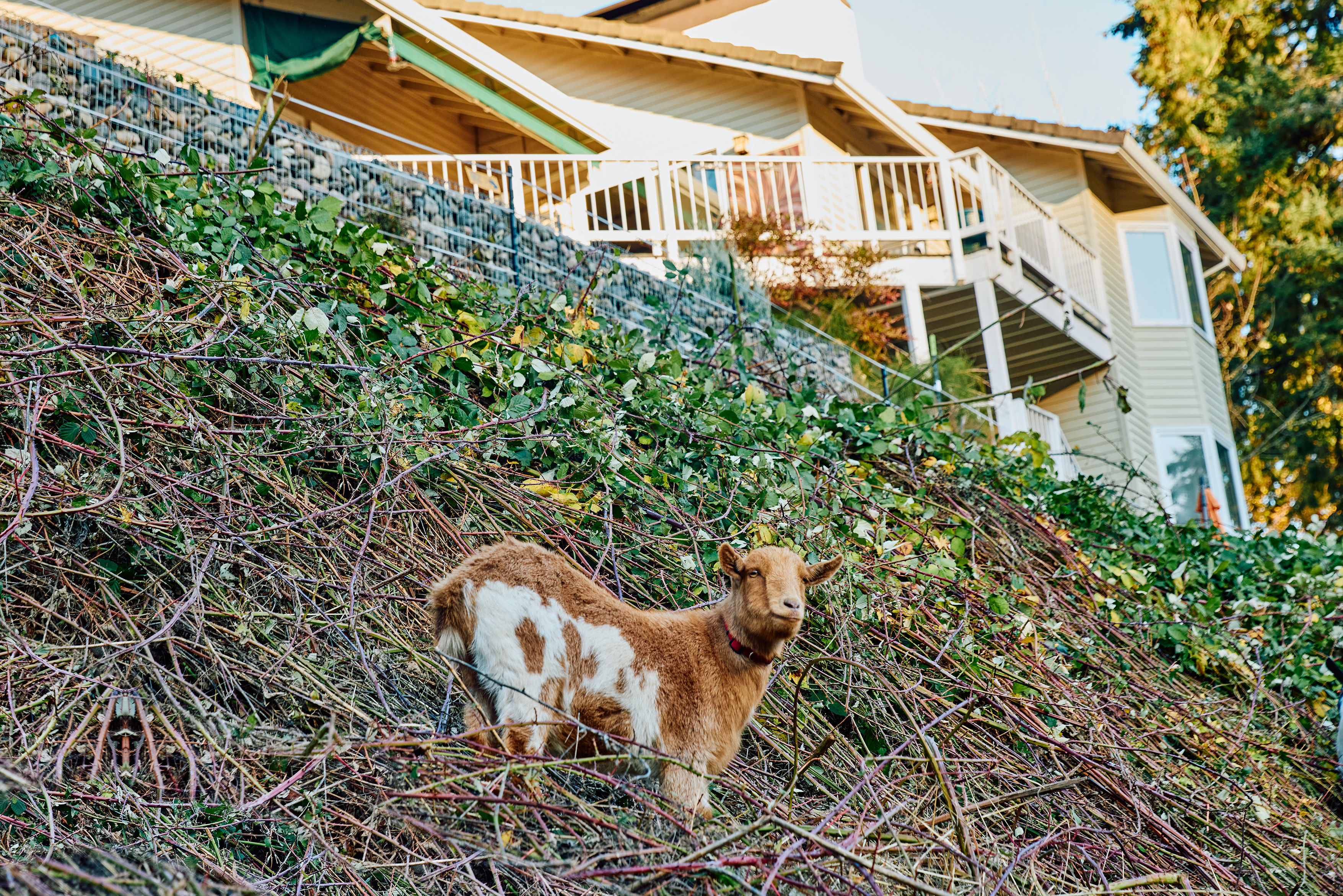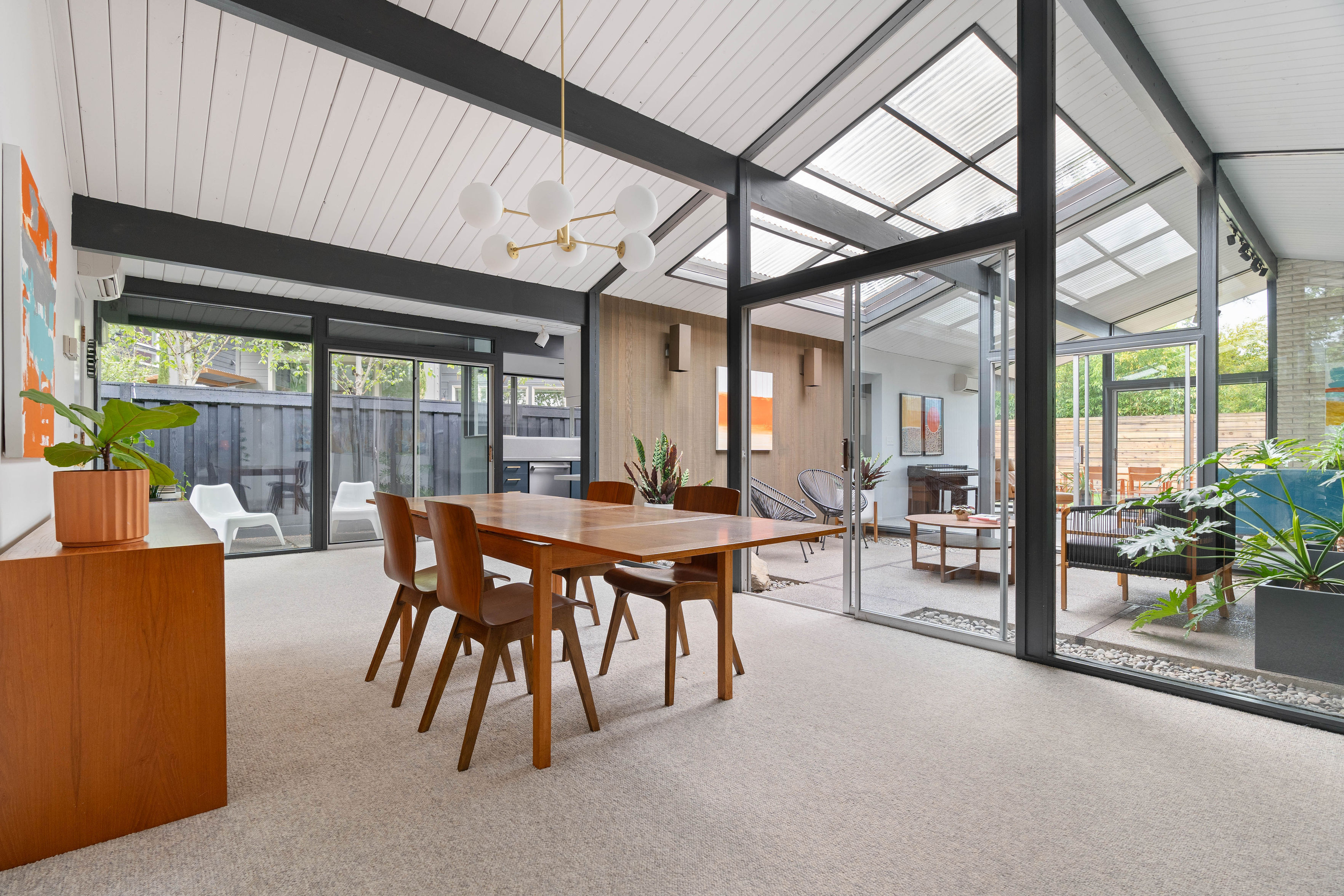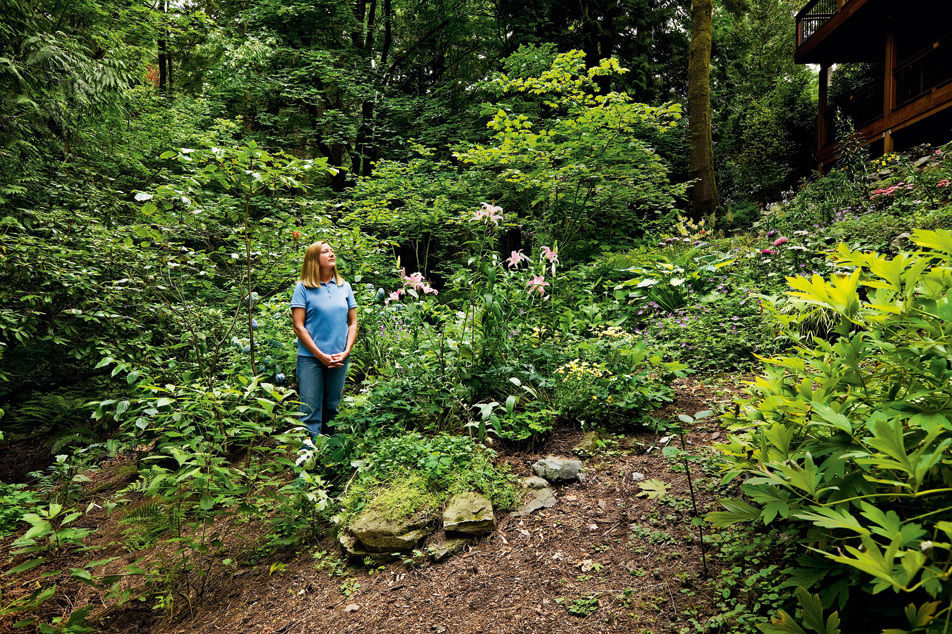
Not in My Backyard
With the temperature nearing 100 degrees, I step into one of the many shady spots behind Carole Kelly’s house and look down the hill toward the Marquam Trail, which runs along the back of her unfenced property. Hikers on the five-mile path that winds through the Southwest Hills often mistake her yard for part of the trail and continue ambling on up the slope just beneath her deck balcony. “I come out here all the time and see people walking into my yard,” Kelly says.
I can see why they’d be confused. Her yard doesn’t look as much like a garden as it does a swath of forest. A 100-foot-tall Douglas fir towers overhead, as does a Western red cedar, and there are other plants, like the bleeding hearts near her deck, that I’ve seen growing in Forest Park. She points out that her vanilla leaf, a shrub native to the Northwest, has been nibbled on by bugs. “That’s nature. That’s what bugs do!” Kelly says, laughing. “I really don’t mind.”
As she walks me through her garden, Kelly says she knows the Latin name for each and every one of the more than 100 different plants that grow here. “See that crazy thing?” she asks in her Florida-native drawl. “That’s a maidenhair fern, or Adiantum aleuticum. It’s a little native guy that just cropped up on his own after we pulled out the ivy. And that thing there? Gosh, What is that called? Oh, and I just told you I knew all of them.”
A moment later, Kelly announces that the shrubby plant with broad leaves is a Philadelphus lewisii, or mock orange, before pointing out several other plants native to the Northwest, such as the Western azalea (Aruncus dioicus). These she has dutifully classified as a deciduous shrub and an herbaceous perennial, respectively, on a two-page chart called “Carole Kelly’s Garden” that she typed up for my benefit.
The 54-year-old nurse admits that she has become a “total plant nerd” since embarking on a project to turn her backyard into a tiny piece of native habitat—which it most certainly was not when Kelly and her husband, Philip Pedigo, moved in six years ago.
Long neglected, the 10th-of-an-acre lot behind their Colonial Revival house was overrun with English ivy, an aggressive invasive plant that covered the slope and snaked some 30 or 40 feet up the native big-leaf maples and Douglas firs growing in the yard. While many people think that English ivy (Hedera helix) imbues a garden with old-world charm, the plant, introduced as an ornamental during Colonial times in America, also grows extremely fast—so fast, in fact, that it beats out other species for light, space, and nutrients. Trees covered with ivy can become so heavy with vines and so starved for food that they eventually topple, and ivy’s root systems are so shallow that a hill covered with the stuff is prone to soil erosion.
All Kelly knew was that she hated the way English ivy looked. “I just wanted it gone,” she says.
And so, armed with loppers and saws, she cut back bunch after bunch of the stuff, and then pulled the vines up by the roots until she had cleared the slope, save for the trees.
But she had no idea what to put in the ivy’s place—not surprising, given that her gardening experience began and ended with houseplants. It took a few months of online research, but Kelly, a consummate do-it-yourselfer, ultimately decided to repopulate her backyard with plants native to the Northwest: those that are adapted to our climate, that are naturally resistant to the region’s pests and diseases, and that require less water. “Basically, I found out that I wouldn’t have to do as much maintenance in the long run if I used native plants, which was key for me,” she says.
A couple thousand bucks spent at Bosky Dell, a native-plant nursery in West Linn, and many mistakes later (“I planted everything in the wrong time of year at first,” she laments), Kelly has become a minor expert in Northwest flora, although she doesn’t shun other species completely. To add splashes of color here and there, she’s also introduced nonnative flowering plants like hostas, echinacea, and phlox, though all are varieties that she knows will not start growing out of control.
The result is a yard that doesn’t simply look “pretty for pretty’s sake.” Instead, Kelly’s garden is a kind of working ecosystem in miniature, one that’s beneficial to native insects and birds. It’s so healthy, in fact, that in April 2007 the Backyard Habitat Certification Program gave it a platinum designation—the highest level in its three-tiered ranking system designed to reward homeowners who turn their yards into biologically diverse habitats.
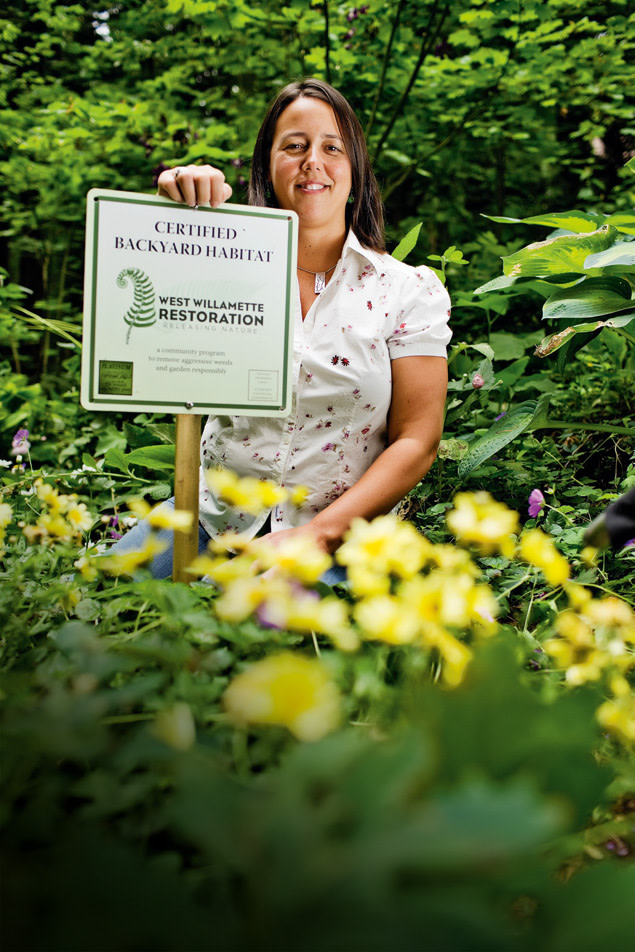
CLAIM TO FAME – Three Rivers program coordinator Gaylen Beatty and one of the signs that she bestows on homeowners whose yards are biologically diverse.
Image: Daniel Root
Headed up by the Lake Oswego-based nonprofit Three Rivers Land Conservancy, the project aims to entice residents who live in ?a 300-acre swath of the West Willamette Corridor—that hilly stretch of land that runs between Forest Park and Tryon Creek State Park—to restore Oregon’s native flora on their own property. Native plants aren’t important simply because they “belong here” or because they don’t require fertilizer the way lawns do, as Douglas W. Tallamy argues in his book Bringing Nature Home: How Native Plants Sustain Wildlife in Our Gardens. They also play a vital role in the healthy functioning of a region’s ecosystem for one easy-to-grasp reason: Most native insects will not eat nonnative plants. To an insect, a backyard enshrouded in English ivy (which so many yards in the West Willamette Corridor are) is a hostile landscape, a place devoid of food. Take away the native insects, and you take away a protein-packed source of food for native birds. In other words, without a diversity of native plants, you lose a diversity of native insects, and the ecosystem itself begins to collapse.
When Kelly embarked on her backyard mission, she wasn’t necessarily thinking about her yard’s role in the bigger ecological scheme of things—and the Backyard Habitat Certification Program didn’t even exist. But it turns out that all of her work was precisely the type that the program’s coordinator, Gaylen Beatty, wants more homeowners to undertake. Kelly already had removed the most aggressive nonnative weeds from her land (including English ivy, garlic mustard, and Himalayan blackberry), and had planted at least 75 percent of her property with native plants. She also had five of six plant and tree “canopy levels,” or varying plant heights, represented—which helps provide habitat for a larger number of species. Predatory birds such as hawks can perch in the branches of tall trees to hunt prey below; songbirds can forage in the fruit-bearing shorter trees, whose branches help shelter them from predators; and ground cover like clover and low-growing shrubs provides habitat for insects, centipedes, and other critters. (“A real piece of forest doesn’t just include Doug firs and oxalis ground cover—it has layers and layers of vegetation,” Beatty notes.)
“My neighbor Courtie just has gold status,” says Kelly, smiling. “I never let her forget that.” Not that Courtie needs another reminder that she still needs to plant about 25 percent more of her property with native plants to reach the top tier: Signs are posted at the very edge of the neighbors’ properties, near Marquam Trail. Both read, “West Willamette Restoration: Releasing Nature.” But each is emblazoned with a sticker of a different color.
Neighborly competition aside, the signs have Marquam Trail hikers stopping to have a look. “Some people probably think, Oh, some tree hugger must live there,” Kelly says, chuckling. “But others are really admiring and say, ‘I love what you’re doing.’ Now, if I could only get this neighbor on board,” she adds, pointing to a house on the left where the yard is still covered in ivy. “But he just thinks I’m nuts.”
In 2001, Three Rivers Land Conservancy acquired 40 acres of forest just north of the Chart House Restaurant on SW Terwilliger Boulevard with the intention of adding to its inventory of 26 natural spaces in Portland. Priority No. 1 for this parcel, says Three Rivers executive director Jayne Cronlund, was to pull all the ivy from the property, much of which was encroaching onto the parkland from the yards of neighboring residents.
“We knew we had to involve local homeowners,” says Cronlund. “But we had to give them some incentive. I couldn’t just knock on people’s doors and say, ‘Hey, get rid of your ivy!’”
Inspired by a backyard habitat program she’d heard about in Atlanta and another, less successful one conducted by the National Wildlife Federation (some of its signs can now be seen around Portland, covered in ivy), Cronlund decided to develop a similar project. With the cooperation of various neighborhood and parks associations (including the Friends of Marquam Nature Park, where Kelly served on the board of directors) and money from the city and private donors, the collaboration became the West Willamette Restoration Partnership, which launched the Backyard Habitat Certification Program in 2007, with Three Rivers at the helm.
The task of actully conferring the platinum, gold, or silver staus on homeowners in the area falls to Gaylen Beatty. When a home-owner who hears about the program in, say, a neighborhood association meeting, calls her up, Beatty dutifully arrives at their home with a boxful of information about good gardening practices.
She then tours the homeowner’s yard, identifies invasive plants, and helps determine which tier is most feasible. (It often takes years to establish multiple canopies, but other rewards can be more immediate: The silver level, for example, only requires homeowners to eradicate aggressive weeds from their property.)
“There really is an element of desperation that comes with having your yard overrun with invasives,” says Beatty, who sometimes arranges free consultations with landscape designers adept at “naturescaping,” or landscaping with native plants. “I am here to tell homeowners, ‘You are not alone in this,’” she says.
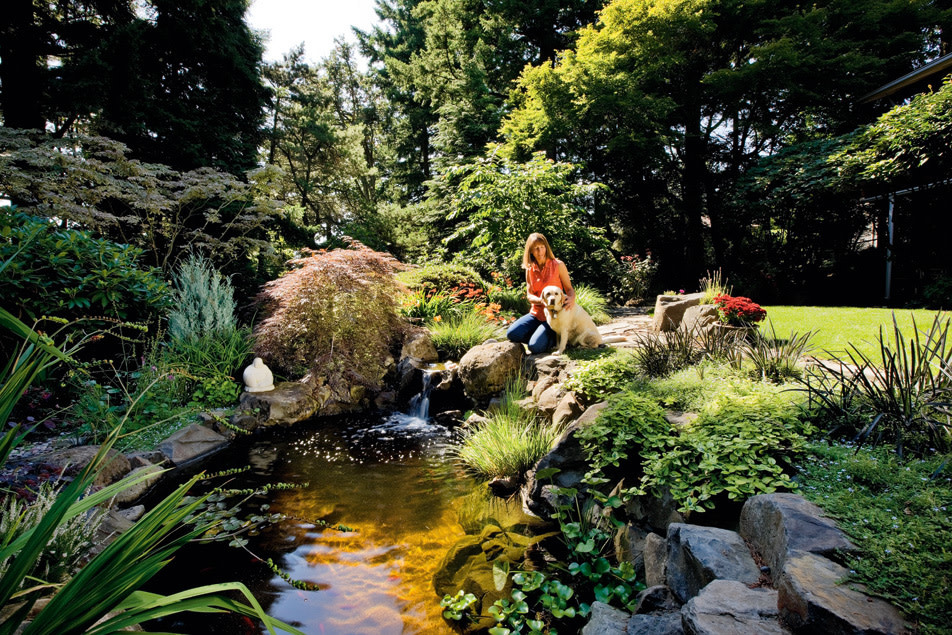
STERLING ACCOMPLISHMENT – Robin Jensen’s yard may be manicured, but enough native plants grow here to earn her a silver award from the West Willamette Restoration Partnership.
Image: Daniel Root
Even though just 50 homeowners are participating so far (and only 17 homeowners have earned signs), the ultimate goal is to prevent the spread of the most aggressive weeds from the targeted area in the West Willamette Corridor by 2019. And by partnering with the Audubon Society, Cronlund intends to take the Backyard Habitat Certification Program citywide next year. By 2012, she hopes to have a thousand homeowners participating.
The idea that a private homeowner might be ethically responsible for what he chooses to plant in his yard is a relatively new one. Bringing Nature Home author Tallamy, who also chairs the department of entomology and wildlife ecology at the University of Delaware, says that the days of “purely ornamental” gardening are over, and argues that a slow cultural shift is taking place in what Americans consider beautiful in their yards.
Tallamy, a frequent visitor to Portland (his son lives here), says the city is in a unique position to set an example for the rest of the country—some 56 percent of which is now developed with suburbs, cities, and four million miles of roads and highways. “Because Portland has Forest Park, it’s better off than most cities,” he tells me. “But you’re still in danger. You can’t ignore the reality that 73 percent of Portland’s original forested areas have been cut down.” Because public parks encompass only about 13 percent of Portland’s landscape, Tallamy argues that private-property owners can make the most immediate, large-scale impact in restoring native habitat.
“It’s not just a matter of telling people what to do as telling them how their plants function in the ecosystem,” says Tallamy. “It’s often amazing to me how many people don’t really know what’s growing in their yards.”
State officials, too, are sounding the alarm on backyard invasives. The Oregon Department of Agriculture estimates that 21 of the 114 plants on its “noxious weed list” cost Oregonians at least $83 million a year in lost revenue and production. An economic study completed in 2000 by the department even determined that a single plant, Scotch broom, was soaking the state for $47 million a year, because it outcompeted trees and subsequently lowered timber production. Like many such aggressive weeds, this low, shrubby plant with tiny yellow flowers probably was first introduced as an ornamental before invading natural areas.
“The important message here is that invasive weeds do not respect ownership boundaries,” says Tim Butler, the manager of the state agriculture department’s noxious weed control program.
Ask mayor-elect Sam Adams who’s to blame for Portland’s problems with invasive species, and he’ll tell you that it’s not homeowners but the city itself. “It’s a mark of shame on city government,” says Adams, who has spent three years as the city’s environmental commissioner. Surveys conducted by the Portland Parks and Recreation Department in 2003 and 2004 rated nearly 23 percent of the city’s natural parklands as “poor” or “severely degraded”—problems officials attributed partly to nonnative plants, which were growing rampant on private land adjacent to the surveyed areas like Forest Park and which were overtaking these spaces. To raise awareness about Portland’s invasive species predicament, Adams has held “Ivy Summits” at City Hall. He’s spent weekends yanking the vine from parks, and has even appointed the city’s first “invasive species czar.”
“People just aren’t connecting the dots about invasives,” says Adams, noting that Portlanders continue to buy the plants at area nurseries. In fact, Adams wants to work with local nurseries and national chain retailers such as Home Depot to stop the sale of the most aggressive nonnative plants altogether. He even wants to institute a 10-year, citywide plan to remove these alien plants from private property. If residents don’t comply, says Adams, their properties could be ranked under the city’s “nuisance” classification, which is primarily reserved for abandoned buildings. “It’s all about establishing a timeline and penalties,” Adams says.
“Nobody in Oregon wants to be told what to do,” says Mark Sytsma, chair of Environmental Science and Management Programs at Portland State University and chair of the Oregon Invasive Species Council. “It’s going to take an overall shift in cultural mind-set. But if we can get people to really want native plants in their yards, we can adjust what they consider beautiful.”
Embracing native gardening does not, however, require people to embrace a wild forest aesthetic as Carole Kelly did. Consider Robin Jensen’s backyard, which is a manicured medley of vibrant flora, including native ferns, oxalis, and fringecup piggyback, as well as flowering nonnatives like fuchsia and dahlias. Koi nip at lily pads floating on the surface of a shallow pool; a stone path cuts through the modest lawn; and the flower bed adjacent to the house is full of heather, daylilies, and azaleas. It’s a good example of how a more orderly, landscaped garden can still be ecologically responsible: Beatty awarded Jensen’s idyllic garden, which cost over $25,000 to pull off, silver-level status last year (though Jensen has been planting a lot more natives in an effort to upgrade her status to gold.)
Jensen and her husband moved into the house in 1992 and immediately tackled their backyard, where ivy vines and blackberry brambles were encroaching from adjacent properties. Jensen, who works at home as an illustrator (she designed the Backyard Habitat sign) calls the ordeal “a losing battle from the beginning.”
After many weekends spent “hacking and beating back” the ivy, she decided in 2006 that enough was enough. Already the president of the Friends of Marquam Nature Park (where she met Kelly), Jensen met with other neighborhood groups in the Hillsdale and Terwilliger areas. It soon became clear that she was only one of hundreds of residents fighting the onslaught of invasives. Like Jayne Cronlund had done, Jensen, Kelly, and other homeowners had begun imagining ways that they might tackle the daunting task of removing invasive plants not just from public parks, but also private property.
“I was so fired up, because if you believe in evolution, you know that diversity is crucial for the propagation of all species,” says Jensen. “And when all you have is ivy growing, that’s a monoculture where nothing else can thrive.”
Two years after connecting with Cronlund and Beatty at Three Rivers, and then joining forces with them to create the West Willamette Restoration Partnership, Jensen now spends 25 to 30 hours a month as a volunteer helping to spread the gospel of responsible landscaping to other neighborhoods.
“Natives aren’t always the most attractive, which is why people are addicted to ornamental plants,” she says. “But there can be a balance. You don’t have to give up the beautiful flowers entirely if you do it the right way. And Gaylen is the queen of getting this message across.”
It’s pouring rain when Beatty picks me up in her red Subaru wagon. Her hair is wet, and even though it’s late August, she is practically dressed for winter in a wool sweater, gray tights, and tall rubber boots. We’re headed up to the Southwest Hills to check on some of the residents whose yards have been certified.
“There is so much momentum with this project right now,” says Beatty. “But I think it’s still a really hard, awkward message to get out—that you need to take responsibility for where you live.”
After we wind our way up the streets, we park on SW Council Crest Drive and knock on the front door of Dan Caulfield, a homeowner whose yard has been certified silver. Caulfield takes us around back to show us the progress he’s made. Since last March, when he and his wife moved in, Caulfield has removed ivy and other invasives from 3,000 square feet of his backyard—a property so large that Beatty enlisted an eight-person AmeriCorps crew to help him pull the ivy. “We blitzed it in a day,” he says.
Without the team of workers, says the 55-year-old Tri-Met operations manager, “I’d still be killing myself out here.” Beatty knows that the labor needed to rid a yard full of invasives is a big challenge for many people, especially if they are older or live alone. “People need to know that all this information and help is available,” Caulfield says.
I look over at a neighboring backyard and see a field of ivy that begins exactly where Caulfield’s ends. I ask him if that’s ?a tough situation, having no control over how his neighbor manages his own ivy problem. He says a 90-year-old gentleman and his daughter live there, and they’ve expressed a “Why pull the ivy if it’s going to come back?” attitude, which Caulfield understands.
“But they did see my sign out front recently,” he says. “And they seemed curious. So I’m hopeful we can get them on board.”
Carole Kelly says that there’s just one last thing she wants to show me before we head inside after our backyard tour. OK, maybe two things. “This is a native strawberry plant, but there is no fruit for humans, as you can see,” she says as we inspect its pointy leaves. “Though the ants get food from it, so that’s really good.” Next to it is the elderberry plant that Sam Adams frequently saw growing up on the Oregon Coast, as he told Kelly when he visited last year.
“This is an example of a native and nonnative living together in harmony,” she says, showing me a native dogwood tree around which a large white Oriental lily has wrapped itself. “Usually you have to stake lilies because they get so tall, but that thing stuck itself in the dogwood! It’s a little party,” she says, obviously delighted that this one small part of her garden provides evidence that the natives and aliens can in fact peacefully coexist. “I mean, just look at that. They really love each other.”
